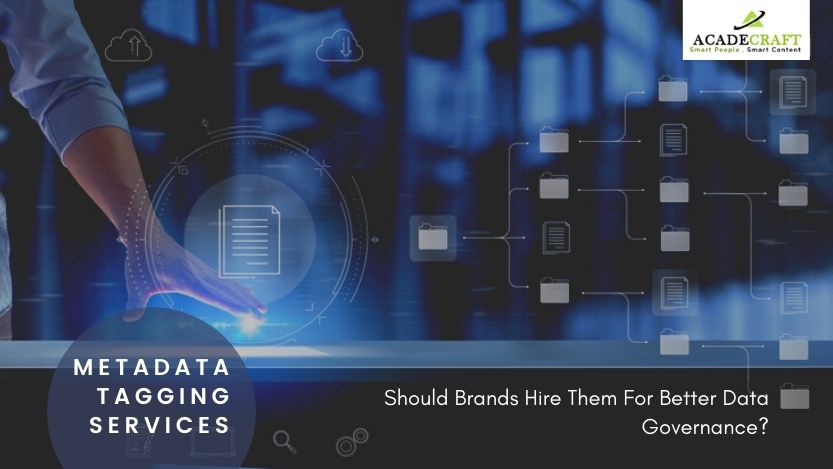
If we look at how traditional file servers work, we?ll find an old and one-dimensional process. Generally, it uses a folder hierarchy whose design and logical structure are out of date. It is no longer a convenient solution to trace out a particular data out of millions. However, Metadata Services bring a much more reliable solution to the desk.
In metadata, there are multiple dimensions for data storage. It makes the process from storing data to searching for it using filters more convenient for your brand.
Today, tagging metadata is the key to the proper classification of official assets and documents. Using metadata, everyone in the organization can have access to the assets.
In fact, the process makes it even easier for employees, clients, and other prospects to browse data.
Metadata structures use different types of tags that transform a simple document into a dynamic one. Generally, these tags are textual words, images, terms, and other such identifying markers. These tags make a particular document or image much more searchable and accessible.
Especially, brands having a lot of digital assets largely benefit from metadata tagging. So, let?s talk about metadata tagging in detail in this blog.
Before coming to the management of metadata, let?s talk about metadata alone. In simple words, ?metadata? is data that describes another data or a set of data.
Metadata summarizes the significant details of a particular data. So, it increases its accessibility in finding and editing digital files. Metadata is primarily useful for organizing unstructured data.
Using Metadata Services, the unstructured data can get a proper classification for itself.
Metadata management is much like database management. Unlike a typical DBMS (Database Management System), metadata is not only a manual process. There are different automated metadata tagging solutions too. And the automated systems run using the help of Machine Learning solutions.
Thus, metadata management is simple and quite convenient for brands.
Metadata tags are usually in the mode of dynamic hypertext. Sometimes, they are also in the form of web links, bookmarks, or keywords.
Usually, brands compare metadata management with the famous card catalog system. It was a popular system found in the libraries back in the pre-internet age. What used to happen then was something similar to how metadata tagging works. To find a book, people needed to find the centralized card catalog of the library. In there, each card is used to contain relevant info about the book. Just like metadata tags, they had various fields and tags.
Thus, finding the book using the card catalog was the best option. Similarly, using metadata tagging, finding any data among other digital assets is the easiest way.
Here are the most common approaches to metadata tagging:
Keyword Tags
Keyword tags are one of the most popular metadata tags that metadata tagging companies incorporate. Usually, keyword tags are descriptive terms assigned with the help of a text field.
Taxonomy metadata tags are pretty famous, too, having varied use. This approach of metadata tagging usually consists of hierarchical keywords.
Field-level tags are text-based metadata tags that are usually short descriptions. These tags have data that are pertinent to a definite collection of digital assets.
As the name suggests, picklist tags consist of different descriptive terms. Users can choose from all the suggested terms or the enforced ones.
These metadata tags contain data and information related to usage rights, patents, asset ownership, intellectual property rights, etc.
Metadata tags provide a straightforward way to find any document in search engines. It helps brands in getting better traffic to their content.
Moreover, it has changed how researching time has turned into seconds from days and weeks. Metadata Tagging Services organize and unify your brand?s data under different relevant categories.
Metadata tagging solutions are all about using a reliable and fast system for organizing digital data and information. Organizing digital assets properly is an essential utility that metadata companies help their clients with.
Let?s talk about the benefits of metadata tagging that brands get for their business -
From keeping data and information in physical cabinets, the world moved into digital platforms. The reason behind that was simple - to categorize data in a better way.
And now, after spending years using folders, it?s finally time we find some better technology. Here, the change is necessary because filling up folders and subfolders have their complications.
Firstly, any user finds it hard to find documents when they need them. And secondly, it is even more challenging for someone to know where to add a new file. Because folders start piling up as soon as data and information flow start incoming.
Metadata solutions are precisely the ones that brands need as a replacement. It plays a significant role in helping brands make data-driven decisions. Using the metadata tags, brands can now store and retrieve data faster than before.
We have seen the use of filters in various websites that deal with selling products or services.
These filters have different text fields where the user can enter any input. Based on the input, they get relevant results. But how does this happen?
Well, the credit goes totally to Metadata Tagging Services. The products that come after filtering the options have their tags. That is why they come in the search results. So, searching and finding for hours metadata is a fluent process, unlike that brands should definitely hire.
Connecting with a professional metadata tagging company is always important for brands. Because doing so will ensure that all connected systems have the tags, categories, and classifications.
Ensuring this makes work progress faster as all workers of brands can collaborate, cooperate and communicate. When they have a common language and accessible data classifications, their understanding increases. As a result, it is your brand that benefits the most out of it.
Without metadata management systems, brands would have missed incorporating valuable insights with their documents. Missing them can be costly as it would also mean that there is a compromise in the customer experience.
Making strategic decisions based on the new insights would also face a challenge without metadata solutions.
So, with the help of that, brands can now generate tons of data using various tools and resources daily.

Metadata tagging is the engine that pushes digital asset management to the next level. Not just for media production or publication, it is also helpful for your brand?s marketing department.
Metadata Services improve the ways how brands organize data and retrieve it whenever needed. Its effectiveness is on the higher side, and we can find more and more brands hiring service providers.
Nonetheless, brands need to be careful while choosing their outsourcing partner. The market has hundreds of metadata tagging companies with their lucrative offerings. However, not all of them are going to match your brand and its requirements.
Moreover, it is important to hire a professional organization because they usually have a promising portfolio. Acadecraft is one such organization, who has gained a fair amount of reputation in the US. Their metadata tagging solutions are some of the most acclaimed ones by their clients globally.
Look no more if your wants motion graphics solutions that provides affordable solutions.
Share